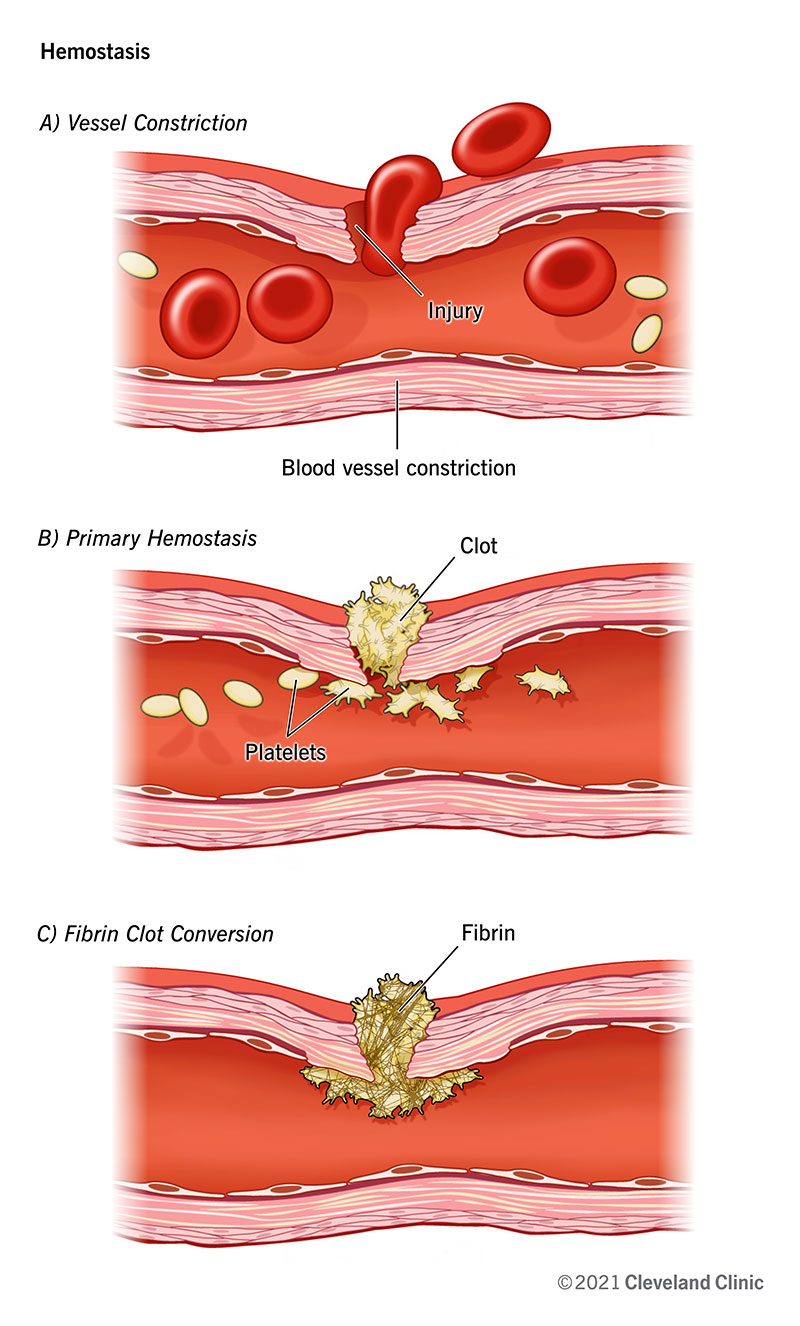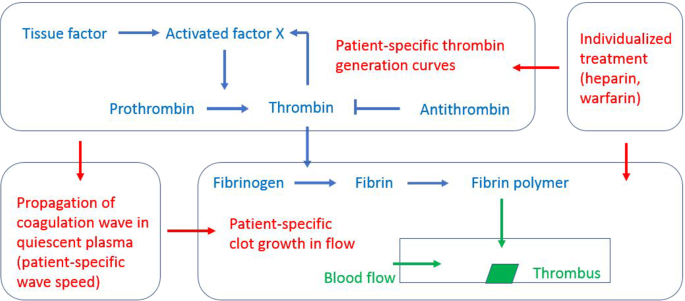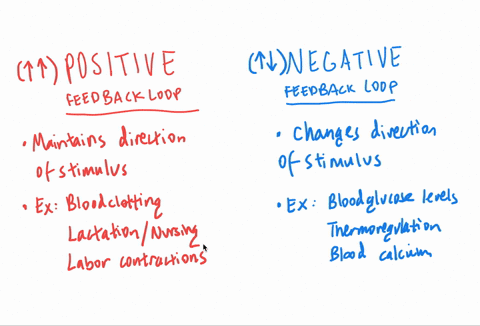Describe the Type of Feedback Mechanism Used for Clotting Blood
Hemostasis is the natural process that stops blood loss when an injury occursIt involves three steps. It is the natural device to check bleeding.

Hemostasis Stages And How The Process Stops Blood Flow
Up to 24 cash back The platelets also interact with fibrinogen a soluble plasma protein to form insoluble fibrin.

. 3 Plasma contains the clotting factors and water while. Blood Clotting Figure 785 The diagram demonstrates positive feedback using the example of blood clotting in the body. At each step in the coagulation cascade feedback mechanisms are required to control the balance between active and inactive thrombin enzymes.
I Formation of thromboplastin. Blood flows through the blood vessels to deliver the needed oxygen and nutrients to the different cells in the body. Just remember that positive feedback mechanisms enhance the original stimulus and negative.
The process of blood coagulation hemostasis is a cascading positive feedback loop. When a wound causes bleeding the body responds with a positive feedback loop to clot the blood and stop blood loss. Describe the mechanism of blood clotting.
The activation of thrombin is regulated by a number of specific thrombin inhibitors. The blood clotting process or. Factor IIIThromboplastin Tissue Factor 4.
It involves two steps. Fibrinogen is the soluble precursor to the insoluble fibrin. The human body protects against loss of blood through the clotting mechanism.
When the body is damaged inside or outside the damaged tissues release factors that cause platelets to adhere to the tissue the effector at the site of the wound. If your blood sugar goes too low the negative feedback loop signals the liver to release glucagon and signals the pancreas to slow the production of insulin. Blood clotting is the transformation of liquid blood into a semisolid gel.
Formation of clot. Vascular mechanisms platelets coagulation factors. The major positive feedback loops of clotting.
An example of positive. 1 Plasma is the part of the blood that contains both the serum and clotting factors. 1 Answer 1 vote.
1 vascular spasm vasoconstriction. Describe a positive feedback system that operates during blood clotting. The activation of TFVII by FXa is the major initiating feedback loop of.
Blood clotting is initiated in one of two ways. Also asked is digestion positive or negative feedback. Other abbreviations are as defined in text.
Open and bold arrows denote the action of an enzyme in catalyzing a reaction. In some cases the positive feed-back is very useful. Solid arrows denote a reaction.
At the point of injury the blood vessels contract and flow of blood is reduced. FACTORS INVOLVED IN BLOOD CLOTTING Coagulation of blood occurs through a series of reactions due to the activation of a group of substances necessary for clotting are called clotting factors. The contraction of uterine wall is caused by oxytocin hormone.
Tests used to identify blood clotting problems will also be presented. This process ends once the vessel wall has been repaired by. Vasoconstriction is a reflex in which blood vessels narrow to increase blood pressure.
Examples of positive feedback loops include cascade of events involved in blood clotting lactation during nursing and uterine contraction during labour. E rst referred to as the intrinsic or internal pathway occurs when a clot forms inside of a blood vessel due to an internal abnormality or an injury to the blood vessel itself8 e second referred to as the extrinsic or exter-. Fibrin strands form a net that entraps more platelets and other blood cells red cells and white cells producing a clot that plugs the break.
The platelets release more chemicals that accelerate the clotting process. If your blood sugar goes too high a signal is sent to the pancreas to release. Positive feedback in blood clotting a blood vessel is damaged chemicals begin a chain reaction that causes platelets to stick to the vessel wall.
Thirteen clotting factors are identified. Another good example of a positive feedback mechanism is blood clotting. The positive feedback loop generally disturbs the homeostasis because the production of end product or result increases continuously and thus crosses the normal value away from the normal value.
Positive feedback is a cyclic process that can continue to amplify your bodys response to a stimulus until a negative feedback response takes over. 2 platelet plug formation. Positive feedback also plays a role in the contractions of the uterus during child birth.
The first factor in the sequence activates the second factor which activates the third factors and so on. Four significant feedback loops are highlighted by bold triple arrows see text. Such as during blood clotting fever child birth breast feeding etc.
There are two mechanisms of regulating the levels of thrombin in the blood system whenever a blood vessel is damaged. Once a vessel is damaged platelets start to cling to the injured site and release chemicals that attract more platelets. For example during blood clotting a cascade of enzymatic proteins activates each other leading to the formation of a fibrin clot that prevents blood loss.
In most cases positive feedback is harmful but there are a few instances where positive feedback when used in limited fashion contributes to normal function. Positive feedback loops control blood clotting and childbirth. Blood is a necessary component of the human body and the loss of this fluid may be life-threatening.
Calcium is required for that. Platelets in the blood start to cling to the injured site and release chemicals that attract additional platelets. Blood is generated via hematopoiesis and ultimately becomes the delivery method for oxygen to the tissues and cells.
Answered Oct 11 2019 by Deepak01 587k points selected Oct 12 2019 by Suchita. Next platelet plug formation involves the activation aggregation and adherence of platelets into a. Positive feedback serves to intensify a response until an endpoint is reached.
Prevent excessive blood loss from the body when there is a. 2 Serum is the part of the blood that remains once the clotting factors like fibrin have been removed. In a positive feedback loop feedback serves to intensify a response until an end point is reachedExamples of processes controlled by positive feedback in the human body include blood clotting and childbirth.
This is due to the fact that thrombin also acts. Once a blood clot starts to form it promotes still more clotting. Share It On Facebook Twitter Email.
Necessity for blood clotting. This type of feedback is normal for the body provided there is a definite endpoint. At the point of injury the platelets disintegrate to form phospholipids.
The platelets continue to pile up and release chemicals until a clot is formed. This series of reactions is called the clotting cascade. Substances released by the injured blood vessel wall begin the process of blood clotting.

Positive And Negative Feedback Loops In Biology

Hemostasis Control Of Bleeding Coagulation And Thrombosis Animation Youtube

Patient Specific Modelling Of Blood Coagulation Springerlink

Coagulation Cascade What Is It Steps And More Osmosis
Solved 1 Which Of The Following Best Illustrates Homeostasis A All Course Hero
7 8 Homeostasis And Feedback Human Biology

Frontiers Red Blood Cell Contribution To Hemostasis Pediatrics

Feedback Loops Anatomy And Physiology I

Chapter 1 Introduction To Anatomy And Physiology Ppt Video Online Download

Feedback Loops Anatomy And Physiology I

Positive And Negative Feedback Homeostasis Biology Dictionary

Solved In What Respect Does Blood Clotting Represent A Negative Feedback Loop What Part Of It Is A Positive Feedback Loop

Positive And Negative Feedback Loops In Biology



Comments
Post a Comment